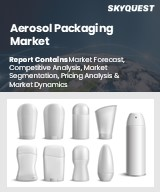
세계의 에어로졸 포장 시장 규모는 2023년에 105억 5,000만 달러로 평가되며, 시장 예측 기간(2025-2032년)에 CAGR 5.84%로 성장하며, 2024년 112억 달러에서 2032년에는 176억 4,000만 달러로 성장할 전망입니다.
에어로졸 포장 시장은 편의성, 위생, 지속가능성에 대한 소비자 수요 증가 등 다양한 요인에 의해 크게 영향을 받고 있습니다. 효과적이고 깨끗한 조제를 보장하는 포장을 선호하는 소비자가 증가함에 따라 퍼스널케어, 가정용품, 헬스케어 분야가 강력한 성장세를 보이고 있습니다. 또한 법과 규제의 압력으로 인해 기업은 재활용 가능한 소재와 친환경 추진제로 기술 혁신을 추진하고 있으며, 진화하는 환경 기준과 더 깨끗한 제품에 대한 상장 기업의 기대에 부응하고 있습니다. 밸브 메커니즘의 개선, 더 가볍고 내구성이 뛰어난 용기 개발 등의 기술 발전은 성능과 지속가능성을 더욱 향상시킵니다. 그러나 제조 비용의 상승과 복잡한 제조 공정, 가압식 에어로졸 캔과 관련된 안전 및 폐기 문제 등이 시장 확산과 전반적인 매출 창출에 걸림돌이 되고 있습니다.
Global Aerosol Packaging Market size was valued at USD 10.55 Billion in 2023 and is poised to grow from USD 11.20 Billion in 2024 to USD 17.64 Billion by 2032, growing at a CAGR of 5.84% during the market forecast period (2025-2032).
The aerosol packaging market is significantly influenced by various factors, including heightened consumer demand for convenience, hygiene, and sustainable practices. As consumers increasingly prefer packaging that ensures effective and clean dispensing, personal care, household, and healthcare sectors witness robust growth. Additionally, regulatory pressures drive companies to innovate with recyclable materials and eco-friendly propellants, aligning with evolving environmental standards and public expectations for cleaner products. Technological advancements, such as improved valve mechanisms and the development of lighter yet more durable containers, further enhance performance and sustainability. However, escalating production costs and complex manufacturing processes present challenges, as do safety and disposal issues associated with pressurized aerosol cans, hindering widespread market penetration and overall revenue generation.
Top-down and bottom-up approaches were used to estimate and validate the size of the Global Aerosol Packaging market and to estimate the size of various other dependent submarkets. The research methodology used to estimate the market size includes the following details: The key players in the market were identified through secondary research, and their market shares in the respective regions were determined through primary and secondary research. This entire procedure includes the study of the annual and financial reports of the top market players and extensive interviews for key insights from industry leaders such as CEOs, VPs, directors, and marketing executives. All percentage shares split, and breakdowns were determined using secondary sources and verified through Primary sources. All possible parameters that affect the markets covered in this research study have been accounted for, viewed in extensive detail, verified through primary research, and analyzed to get the final quantitative and qualitative data.
Global Aerosol Packaging Market Segments Analysis
The global aerosol packaging market is segmented by material, by product type, by application, by end-use, and region. Based on the material, the market is segmented into steel, aluminum, and others. Based on the product type, the market is segmented into cans, jars, bottles, cylinders, and others. Based on the application, the market is segmented into inhalers, cleaners, deodorants, insecticides, sprayable flavors, greases & lubricants, and others. Based on end use, the market is segmented into industrial, automotive, pharmaceutical, paint & coating, food & beverage, household products, cosmetics & personal care, and others. Based on the region, the market is segmented into North America, Europe, Asia Pacific, Latin America, and the Middle East and Africa.
Driver of the Global Aerosol Packaging Market
The Global Aerosol Packaging market is significantly driven by the rising consumer demand for convenience and hygiene. Aerosol containers facilitate easy application with a simple press, allowing users to effectively and accurately dispense products while minimizing waste and mess. Their hermetically sealed design ensures that contents remain clean and protected from tampering or leakage, promoting sanitary use and extending shelf life. This combination of user-friendly dispensing and enhanced safety aligns perfectly with modern lifestyles, making aerosol packaging increasingly attractive in sectors such as personal care, food, and pharmaceuticals. The versatility and practicality of aerosol solutions cater to evolving consumer preferences and needs.
Restraints in the Global Aerosol Packaging Market
The aerosol packaging industry faces significant challenges due to elevated manufacturing and operational costs, which stem from substantial capital investments in specialized equipment, high-quality raw materials, and stringent quality control measures. Ongoing expenses related to energy, workforce, and compliance with strict regulations further inflate operational costs, putting pressure on profit margins and hindering market entry for new players. Additionally, fluctuations in the prices of raw materials, particularly metals like aluminum, create financial instability and complicate long-term strategic planning for manufacturers. These financial pressures can slow down innovation and growth, making it increasingly difficult for companies to offer competitive prices while maintaining quality and sustainability standards.
Market Trends of the Global Aerosol Packaging Market
The Global Aerosol Packaging market is witnessing a robust trend towards sustainability and eco-friendly solutions, driven by increasing environmental concerns, stringent regulations, and evolving consumer preferences for recyclable and biodegradable products. Manufacturers are increasingly prioritizing lightweight, refillable, and recyclable materials such as aluminum and post-consumer recycled plastics, while also innovating low-impact propellants and biodegradable coatings to minimize ecological impact. Furthermore, regulatory frameworks, including extended producer responsibility initiatives, are urging companies to adopt sustainable practices and invest in circular packaging systems. This shift not only addresses pressing environmental challenges but also enhances brand competitiveness as sustainability becomes a key factor in consumer purchasing decisions and market positioning.